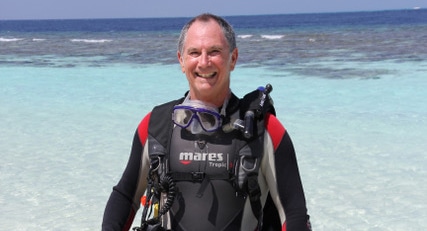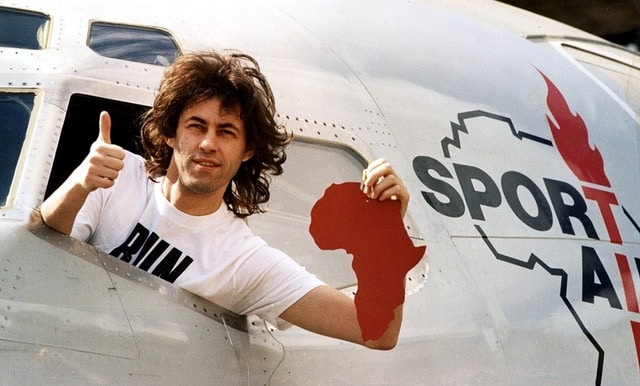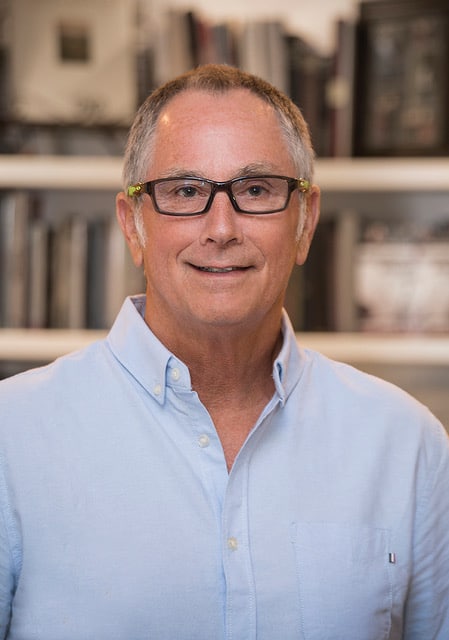Marine Life & Conservation Blogs
Earthdive – a global project to save our oceans (Part 1)

Introduced by Jeff Goodman
Many years ago on returning from a film trip to Indonesia for the BBC I was met at the airport by Chris Long. We met in the arrivals cafe where he told me of his new project earthdive, a revolutionary concept in citizen science and a global research project for millions of recreational scuba divers, snorkellers and others who can help preserve the health and diversity of our oceans. He asked if I would be interested to be part of it. For the following year I worked with Chris helping to develop this immense project.
 Chris was the founder and force behind Sport Aid and Run the World, the biggest mass participation demonstration our planet has ever seen. Inspired by Bob Geldof and Band Aid, Chris organised this game-changing event 34 years ago. It involved almost 20 million people in 89 countries, running simultaneously to demand action for the famine victims of Ethiopia and Sudan.
Chris was the founder and force behind Sport Aid and Run the World, the biggest mass participation demonstration our planet has ever seen. Inspired by Bob Geldof and Band Aid, Chris organised this game-changing event 34 years ago. It involved almost 20 million people in 89 countries, running simultaneously to demand action for the famine victims of Ethiopia and Sudan.
I Ran The World – Sport Aid is Chris’s new book that details how the former hydroponicist galvanised Bob Geldof, world leaders, celebrities, rock stars and royalty to help change the world. In the process he not only raised £32 million for charity but also succeeded in pressurising governments into cancelling US$100 million of African debt. At the latter end of the book, it tells of the natural progression to try and save our oceans.
 Chris Long – earthdive
Chris Long – earthdive
When I was five I dreamed of being a scuba diver.
It never happened, something got in the way.
Thirty five years ago, I went to Live Aid and it changed my life.
 One year later, I founded and organised the biggest mass participation in history, raising £35m for Band Aid, UNICEF and a handful of other international charities and NGO’s. My event, Sport Aid and Run the World, involved 19.8 million people in 89 countries running 10k through their cities to help change the world.
One year later, I founded and organised the biggest mass participation in history, raising £35m for Band Aid, UNICEF and a handful of other international charities and NGO’s. My event, Sport Aid and Run the World, involved 19.8 million people in 89 countries running 10k through their cities to help change the world.
I worked with rock stars, celebrities, royalty, world leaders, athletes and many international sports stars. I met Charles and Diana at Buckingham Palace, had tea with Margaret Thatcher at Number Ten Downing Street and was honoured by the United Nations.
My book I Ran the World, tells the whole story and in Chapter 20 ‘New Beginnings’ I tell the story of how my dream as a five year old finally came true.
Biography
 On the surface Chris Long is a regular guy. But scratch a little deeper and you’ll discover an astonishing secret: the founder/director of Earthdive, a company devoted to protecting our oceans, was also the founder and force behind Sport Aid and Run the World, the biggest mass participation demonstration our planet has ever seen.
On the surface Chris Long is a regular guy. But scratch a little deeper and you’ll discover an astonishing secret: the founder/director of Earthdive, a company devoted to protecting our oceans, was also the founder and force behind Sport Aid and Run the World, the biggest mass participation demonstration our planet has ever seen.
Inspired by Bob Geldof and Band Aid, Chris organised this game-changing event 34 years ago. It involved almost 20 million people in 89 countries, running simultaneously to demand action for the famine victims of Ethiopia and Sudan.
He has now written a riveting book on how it all happened.
I Ran the World details how the former hydroponicist galvanised Bob Geldof, world leaders, celebrities, rock stars and royalty to help change the world. In the process he not only raised £32 million for charity but also succeeded in pressurising governments into cancelling US$100 million of African debt.
His racy autobiography reveals the triumphs and tragedies behind that turbulent time. How he imitated Bob Geldof to ensure Birmingham’s Olympic bid team got on board, convinced the head of UNICEF to partner Band Aid, met Prince Charles and Princess Diana at Buckingham Palace and took tea with Margaret Thatcher at Number Ten Downing Street – not to mention how close he came to committing suicide along the way.
In the foreword, former UNICEF Head of Special Events Dr. John C Anderson says: “Chris Long had a vision and a dream. He believed that people could do more than listen to music and make donations, they could actively engage in the cause – and what better vehicle than sport?
“I Ran the World is the story of how one man mobilised a team of 130 young volunteers in a small office in London, secured the support of huge organisations like UNICEF and Band Aid and then mobilised 20 million people around the world to run and demand action for Africa.”
Chris agonised over writing his book for three decades: laying bare the exultation, high notes and happiness behind his superhuman achievement. . . tempered with the blood, sweat, tears, depression and despair when it all came tumbling down.
But he decided too many people were ignoring the current crises – climate change, marine pollution, overfishing, the population explosion, the ongoing agony of refugees fleeing religious and ideological wars. And he has challenged today’s young people to take up his baton.
“We’re living in dangerous times,” he says. “And never more so than during this pandemic. Finding a remedy is a matter of survival and that solution lies with all of us, not just our elected representatives. We can and must change the world in which we live. That’s why I wrote this book.”
Come back tomorrow to read an extract from the book….
I Ran the World by Chris Long is available on Amazon Books here.
Visit www.earthdive.com to find out more!
Blogs
The Ocean Cleanup Breaks 10,000,000 KG Barrier

The Ocean Cleanup, the global non-profit project, has removed a verified all-time total of ten million kilograms (22 million lbs.) of trash from oceans and rivers around the world – approximately the same weight as the Eiffel Tower.
To complete its mission of ridding the oceans of plastic, The Ocean Cleanup uses a dual strategy: cleaning up the Great Pacific Garbage Patch (GPGP) to remove the plastic already afloat in the oceans, while stopping the flow of plastic from the world’s most polluting rivers.
Through cleaning operations in the GPGP and in rivers in eight countries, the cumulative total of trash removed has now surpassed ten million kilograms. This milestone demonstrates the acceleration of The Ocean Cleanup’s impact, while underlining the astonishing scale of the plastic pollution problem and the need for continued support and action.
While encouraging for the mission, this milestone is only a staging point: millions more tons of plastic still pollute our oceans and The Ocean Cleanup intends to continue learning, improving and innovating to solve this global catastrophe.
This announcement comes as governments from around the world meet to continue negotiations to develop a new legally binding instrument to end plastic pollution at INC4 in Ottawa, Canada. Representatives of The Ocean Cleanup will be in attendance and the organization will be urging decision-makers to collaborate towards a comprehensive and ambitious global treaty which addresses plastic at all stages of its life cycle and in all marine environments worldwide, including in areas beyond national jurisdiction.
It is encouraging to see that the need for remediation is reflected in the various options for potential treaty provisions. It is essential that the final treaty contains clear targets for the remediation of legacy plastic pollution, and reduction of riverine plastic emissions.
Tackling plastic pollution requires innovative and impactful solutions. The treaty should therefore incentivize the innovation ecosystem by fostering innovations that make maximal use of data, technology and scientific knowledge – such as those designed and deployed by The Ocean Cleanup.
‘After many tough years of trial and error, it’s amazing to see our work is starting to pay off – and I am proud of the team who has brought us to this point.’ said Boyan Slat, Founder and CEO of The Ocean Cleanup. ‘While we still have a long way to go, our recent successes fill us with renewed confidence that the oceans can be cleaned.’
The Ocean Cleanup was founded in 2013 and captured its first plastic in 2019, with the first confirmed catch in the GPGP coming soon after the deployment of Interceptor 001 in Jakarta, Indonesia. After surpassing one million kilograms of trash removed in early 2022, the non-profit project has since progressed to the third iteration of its GPGP cleaning solution, known as System 03, and a network of Interceptors currently covering rivers in eight countries, with more deployments set for 2024.
About The Ocean Cleanup
The Ocean Cleanup is an international non-profit organization that develops and scales technologies to rid the world’s oceans of plastic. They aim to achieve this goal through a dual strategy: stemming the inflow via rivers and cleaning up the legacy plastic that has already accumulated in the ocean. For the latter, The Ocean Cleanup develops large-scale systems to efficiently concentrate the plastic for periodic removal. This plastic is tracked and traced through DNV’s chain of custody model to certify claims of origin when recycling it into new products. To curb the tide via rivers, The Ocean Cleanup has developed Interceptor™ solutions to halt and extract riverine plastic before it reaches the ocean. Founded in 2013 by Boyan Slat, The Ocean Cleanup now employs a broadly multi-disciplined team of approximately 140. The foundation is headquartered in Rotterdam, the Netherlands.
For more information, visit: theoceancleanup.com and follow @theoceancleanup on social media.
Marine Life & Conservation Blogs
Creature Feature: Dusky Shark

 In this series, the Shark Trust will be sharing amazing facts about different species of sharks and what you can do to help protect them.
In this series, the Shark Trust will be sharing amazing facts about different species of sharks and what you can do to help protect them.
This month we’re taking a look at the Dusky Shark, a highly migratory species with a particularly slow growth rate and late age at maturity.
Dusky sharks are one of the largest species within the Carcharhinus genus, generally measuring 3 metres total length but able to reach up to 4.2 metres. They are grey to grey-brown on their dorsal side and their fins usually have dusky margins, with the darkest tips on the caudal fin.
Dusky Sharks can often be confused with other species of the Carcharhinus genus, particularly the Galapagos Shark (Carcharhinus galapagensis). They have very similar external morphology, so it can be easier to ID to species level by taking location into account as the two species occupy very different ecological niches – Galapagos Sharks prefer offshore seamounts and islets, whilst duskies prefer continental margins.
Hybridisation:
A 2019 study found that Dusky Sharks are hybridising with Galapagos Sharks on the Eastern Tropical Pacific (Pazmiño et al., 2019). Hybridisation is when an animal breeds with an individual of another species to produce offspring (a hybrid). Hybrids are often infertile, but this study found that the hybrids were able to produce second generation hybrids!
Long distance swimmers:
Dusky sharks are highly mobile species, undertaking long migrations to stay in warm waters throughout the winter. In the Northern Hemisphere, they head towards the poles in the summer and return southwards towards the equator in winter. The longest distance recorded was 2000 nautical miles!
Very slow to mature and reproduce:
The Dusky Shark are both targeted and caught as bycatch globally. We already know that elasmobranchs are inherently slow reproducers which means that they are heavily impacted by overfishing; it takes them so long to recover that they cannot keep up with the rate at which they are being fished. Dusky Sharks are particularly slow to reproduce – females are only ready to start breeding at roughly 20 years old, their gestation periods can last up to 22 months, and they only give birth every two to three years. This makes duskies one of the most vulnerable of all shark species.
The Dusky Shark is now listed on Appendix II of the Convention on the Conservation of Migratory Species (CMS), but further action is required to protect this important species.
Scientific Name: Carcharhinus obscurus
Family: Carcharhinidae
Maximum Size: 420cm (Total Length)
Diet: Bony fishes, cephalopods, can also eat crustaceans, and small sharks, skates and rays
Distribution: Patchy distribution in tropical and warm temperate seas; Atlantic, Indo-Pacific and Mediterranean.
Habitat: Ranges from inshore waters out to the edge of the continental shelf.
Conservation status: Endangered.
For more great shark information and conservation visit the Shark Trust Website
Images: Andy Murch
Diana A. Pazmiño, Lynne van Herderden, Colin A. Simpfendorfer, Claudia Junge, Stephen C. Donnellan, E. Mauricio Hoyos-Padilla, Clinton A.J. Duffy, Charlie Huveneers, Bronwyn M. Gillanders, Paul A. Butcher, Gregory E. Maes. (2019). Introgressive hybridisation between two widespread sharks in the east Pacific region, Molecular Phylogenetics and Evolution 136(119-127), https://doi.org/10.1016/j.ympev.2019.04.013.
-

 News3 months ago
News3 months agoCapturing Critters in Lembeh Underwater Photography Workshop 2024: Event Roundup
-

 Marine Life & Conservation Blogs3 months ago
Marine Life & Conservation Blogs3 months agoCreature Feature: Swell Sharks
-

 Blogs2 months ago
Blogs2 months agoMurex Resorts: Passport to Paradise!
-

 Blogs2 months ago
Blogs2 months agoDiver Discovering Whale Skeletons Beneath Ice Judged World’s Best Underwater Photograph
-

 Gear Reviews3 weeks ago
Gear Reviews3 weeks agoGEAR REVIEW – Revolutionising Diving Comfort: The Sharkskin T2 Chillproof Suit
-

 Gear Reviews3 months ago
Gear Reviews3 months agoGear Review: Oceanic+ Dive Housing for iPhone
-

 Marine Life & Conservation2 months ago
Marine Life & Conservation2 months agoSave the Manatee Club launches brand new webcams at Silver Springs State Park, Florida
-

 News2 months ago
News2 months agoPADI Teams Up with Wellness Brand Neuro to Drive Ocean Change and Create a Blue State of Mind



















